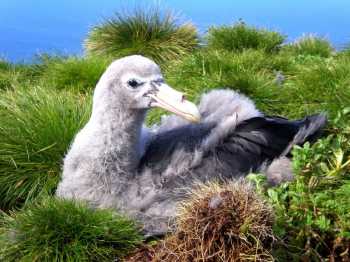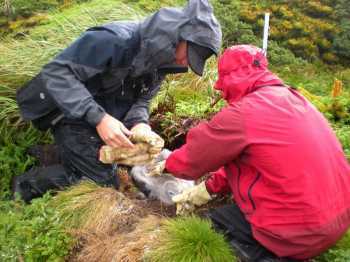It must now be well known that the Tristan Albatrosses Diomedea dabbenena and several other seabird species that breed on Gough Island are deleteriously affected by attacks on their chicks by the introduced House Mouse Mus musculus. For news of how badly the Tristan Albatrosses fared in 2010 click here.
However, one ACAP-listed Gough seabird that hitherto has not been adequately checked for signs of attacks by mice is the Southern Giant Petrel Macronectes giganteus. The species breeds at some distance from the South African meteorological station so its colonies have been rarely visited.
This summer a demographic study on the nearest (and largest) giant petrel colony has commenced (click here). The latest visit to the colony below Low Hump over 22-23 December to band the half-downy chicks showed no signs of the characteristic attacks caused by mice on albatrosses - mainly open wounds on the rump, back and head, and no skeletonised corpses at the nests.
A total of 164 eggs was laid in the study colony, and 118 healthy chicks were present last month. All or nearly all of these are expected to fledge in due course, resulting in a breeding success of 72%. This figure compares favourably with an average breeding success of only 31% (range 17-63%) in study colonies at Marion Island in the southern Indian Ocean over the period 1983-1995 (Cooper et al. 2001). Hatching success on Gough this summer is calculated as 79%, also much higher than the Marion average of 43%.
The study has been funded by a Captain Simpson Scholarship by the Royal Naval Birdwatching Society. The support of the Royal Society for the Protection of Birds, the South African National Antarctic Programme and the Tristan Conservation Department is gratefully acknowledged. Thanks to Ross Cowlin and Michelle Steenkamp for information.
Reference:
Cooper, J., Brooke, M.deL., Burger, A.E., Crawford, R.J.M., Hunter, S. & Williams, A.J. 2001. Aspects of the breeding biology of the Northern Giant Petrel (Macronectes halli) and the Southern Giant Petrel M. giganteus) at sub-Antarctic Marion Island. International Journal of Ornithology 4: 53-68.
John Cooper, ACAP Information Officer, 2 January 2011

 English
English  Français
Français  Español
Español 
